There are many different email marketing attribution models. Each one has strengths and weaknesses. The best way to choose an attribution model for your business is to consider all your marketing channels and the ideal path to conversion, then ask yourself: “What do I want to learn by using an attribution model?”
What you want to learn about your marketing efforts will determine which attribution model you use. Here are 8 common attribution models that you might consider.
- Last Non-Direct Click Attribution — If you’re a fan of Google Analytics, then you might be familiar with this attribution model, or at least you should be, because this is Google Analytic’s default revenue tracking attribution model. Essentially, conversion credit goes to the last action taken by the customer, with one exception: this attribution model excludes all direct traffic.
- Example: Sally clicks on a Google Ad for your business and puts on item in her cart. She then abandons cart. Two days later, she clicks on your abandoned cart email and visits your site again, but still doesn’t convert. The next day, she goes directly to your website and finishes her purchase. With the Last Non-Direct Click Attribution model, credit goes to your abandoned cart email.
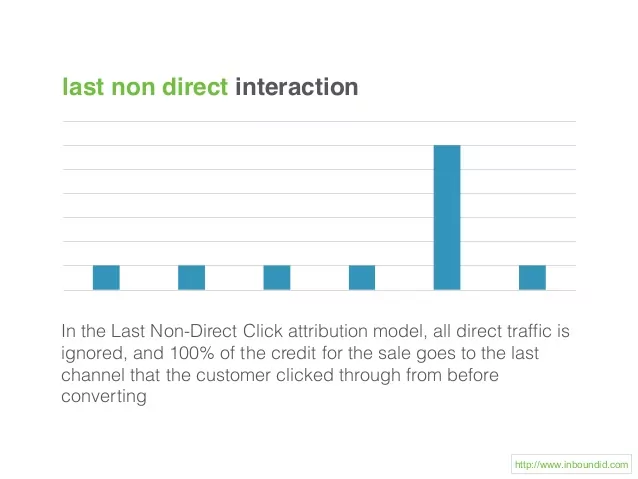
- Last Click Attribution — The last-click attribution model, quite simply, gives credit to the last place which the customer clicked before converting. This is a useful attribution model for tracking the immediate effectiveness of your marketing materials, but keep in mind that other previous communication likely had an impact on the customer’s purchase decision as well, even though this attribution model gives no credit to those previous channels.
- Example: Tim clicks on your email which prompts him to take advantage of a 50%-off sale. He leaves without converting. Two days later, he clicks on your retargeting Facebook ad campaign but again, doesn’t convert. The next day, he clicks on one of your organic social media post and finishes his purchase. With the Last Click Attribution model, your organic social media post would receive all credit for conversion.
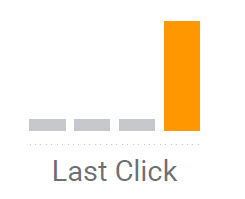
- First Click Attribution — Opposite of the Last Click Attribution model is the First Click Attribution Model. Instead of crediting the last place clicked with conversion, this attribution model gives all credit to the first place that the customer engaged. This is an effective attribution model if you want to give conversion credit to whichever channel generated the lead in the first place, but keep in mind that many other channels likely had an impact on the conversion as well.
- Example: Tom clicks on your Facebook ad campaign which drives him to your free downloadable resource on your website. He downloads the resource and joins your email list. Over the next week, he clicks on several of your emails and social media posts without converting. Finally, he clicks on your abandoned cart campaign and finishes his purchase. With the First Click Attribution model, all conversion credit goes to the original Facebook ad campaign which got Tom on your list in the first place.

- Control Groups — Technically speaking, this isn’t an attribution model, but rather a method of testing and determining how valuable your email campaigns are for your business. Because when it comes to email marketing attribution, that’s the question we’re trying to answer: how much revenue are your email campaigns generating for your business? The best way to answer that question is to run a test with different control groups. For a set period of time, send no emails to a statistically significant, randomized portion of your customer list. At the same time, continue sending your normal marketing emails to the rest of your customer list. In the end, measure how much money email receivers spent up against how much non-email-receivers spent. The difference between those two numbers is one way to measure the tangible value of your email marketing campaigns.
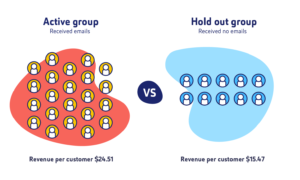
- Position Based Attribution — In an attempt to level the playing field and give proportional credit to each channel that influenced the customer’s buying journey, the Position Based Attribution model gives 40% credit both to the first and last interaction, and the remaining 20% credit is divvied up evenly among the middle interactions. This attribution model operates under the assumption that every channel a customer visited before buying had some sort of impact on their final decision, but none so much as the first and last place where that customer engaged.
- Example: Suzy clicks on your Facebook ad for a downloadable resource where she opts-in to your email list. A few days later, she clicks an email with a discount code and puts the item in her cart before abandoning. The next day, she click on your abandoned cart email but still doesn’t convert. Finally, she clicks on your retargeting Facebook ad campaign for the same item and finishes her purchase. With the Position Based Attribution model, Facebook ad campaigns would receive 80% of the credit (since that was both the first and last interaction) and your email campaigns would receive the remaining 20% of credit.
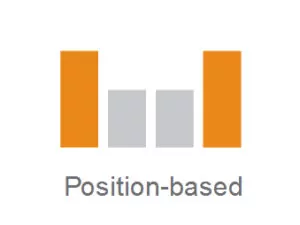
- Linear Attribution — While most attribution models give the most credit to either the first interaction (where the lead originally came from) or the last interaction (the final trigger before purchasing), the Linear Attribution model gives equal credit to all channels which played any type of roll in the customer’s journey before buying. While this attribution model might not help you determine which channels are most effective at converting customers or generating leads, it can help you determine which channels your customers are engaging with the most consistently.
- Example: Phil visits your website directly and signs up for your email list. He clicks on an email with a 20%-off coupon, but doesn’t convert. He then clicks on your Facebook ad campaign, but still doesn’t convert. Finally, he clicks on your abandoned cart email and finishes his purchase. With the Linear Attribution model, direct traffic, the coupon email, your Facebook ad campaign, and the abandoned cart email all receive equal credit for the conversion.
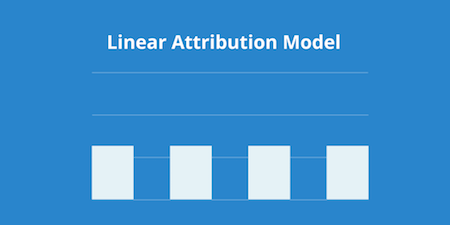
- Time Decay Attribution — The Time Decay Attribution model provides yet another proportional way to divvy up points among channels that influenced conversion. Placing the most value upon the last interaction before conversion, the Time Decay Attribution model gives the most credit to the final touch-point and decreasing credit to each following touch-point. If you value the conversion event most and want to track which channels have the greatest consistent impact on conversion, the Time Decay Attribution model might be your ticket.
- Example: Sam clicks on your Google ad campaign and signs up for your email list. She doesn’t purchase. A few days later, she clicks on one of your Facebook ad campaigns without converting. And a few days later still, she visits your website directly without purchasing. The next day, she clicks on one of your email campaigns and completes her purchase. With the Time Decay Attribution model, the most conversion credit would go to your email campaign and the least would go to your Google ad campaign.
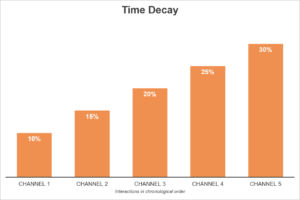
- Custom Attribution — If you’ve been working in your industry for a long time and you feel that you have a sense for which points of a customer journey matter the most for conversion, then you might decide to create your Custom Attribution model. With a Custom Attribution model, you give more credit to touch-points you believe are critical and less credit to touch-points you believe are inconsequential. But be careful, this can be a bit self-defeating since you’d be making assumptions about which marketing channels are the most effective for conversion, that being the very goal of having an attribution model in the first place.

